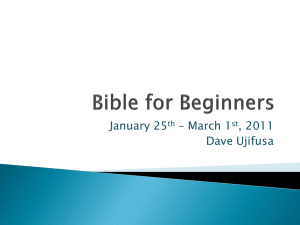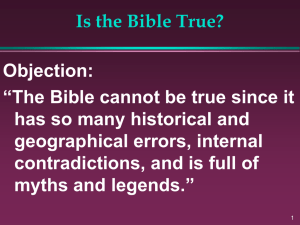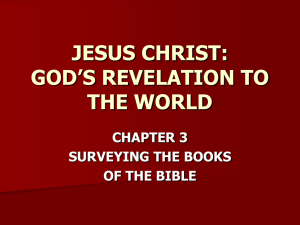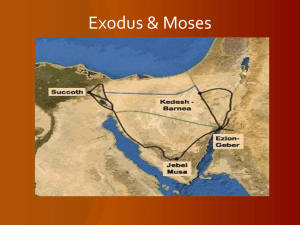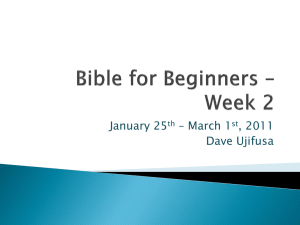How to teach basic SDA doctrine
advertisement
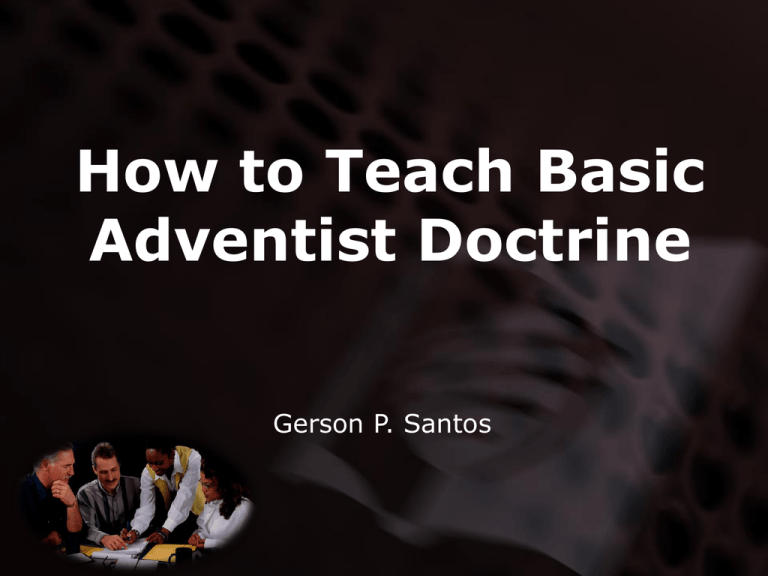
How to Teach Basic Adventist Doctrine Gerson P. Santos I. Introduction to the Bible 1. Revelation • “revelo” – to remove the veil, to manifest, to discover… • Definition: the automanifestation of God to the human being, without that we will never come to know Him. I. Introduction to the Bible 1. Revelation • General Nature Conscience History • Special Scriptures – John 5:39 Jesus – Hebrews 1:1-3 Miracles – John 5:36 Others – Daniel 2:27-28 I. Introduction to the Bible 2. Inspiration - “Theopneustos” – breath of God, divine air in movement - II Timothy 3:16 - II Peter 1:19-21 I. Introduction to the Bible 2. Inspiration - Theories of Inspiration: - Natural - Partial - Verbal - Dynamic – SDA position I. Introduction to the Bible 3. Bible Original Languages - “biblion” – collection of books - Old Testament – Hebrew - New Testament – Greek I. Introduction to the Bible 5. Formation of Bible Text - Ezra / Nehemiah (OT) 430 – 420 BC - Christian Church (NT) 2nd-4th Century - Council of Hipona (393) and Cartage (397) - Chapters - Eulalie – 5th Century - Verses – Robert Stefano – 16th Century I. Introduction to the Bible 6. Books of the Bible - - Old Testament (39 Books) - Law – Pentateuch - History / Psalms - Prophecy New Testament (27 Books) - Gospels - Acts / Epistles - Universal Epistles - Revelation I. Introduction to the Bible 6. Books of the Bible - Approximately 44 authors - 1,500-year period 1st: Job/Genesis – Moses (circa 1,450 BC Last: Revelation/Gospel of John – John (96 AD) II. Ten Steps for Bible Interpretation 1. Divine authorship through human language. 2. The Bible interprets itself. 3. Consider the general context of Scriptures. 4. Consider the immediate context. II. Ten Steps for Bible Interpretation 5. Consider the historic context. 6. Start with the literal meaning. 7. Utilize other translations. II. Ten Steps for Bible Interpretation 8. Determine the literary style. 9. Know the difference: interpretation, reinterpretation, and application. 10. Be willing to accept new things. IV. SDA Beliefs 1872 - Synopsis of our Faith 1931 - 22 Fundamental Beliefs 1980 - 27 Fundamental Beliefs 2005 – 28 Fundamental Beliefs The 28 Fundamental Beliefs The Doctrine of God 1. The Word of God 2. The Godhead 3. The Father 4. The Son 5. The Holy Spirit The 28 Fundamental Beliefs The Doctrine of Man 6. The Creation 7. The Nature of Man The 28 Fundamental Beliefs The Doctrine of Salvation 8. The Great Controversy 9. The Life, Death, and Resurrection of Christ 10. The Experience of Salvation 11. Growing in Christ The 28 Fundamental Beliefs The Doctrine of the Church 12. The Church 13. The Remnant and Its Mission 14. Unity in the Body of Christ 15. Baptism 16. The Lord’s Supper 17. Spiritual Gifts and Ministries 18. The Gift of Prophecy The 28 Fundamental Beliefs The Doctrine of the Christian Life 19. The Law of God 20. The Sabbath 21. Stewardship 22. Christian Behavior 23. Marriage and Family The 28 Fundamental Beliefs The Doctrine of the Christian Life 24. Christ’s Ministry in the Heavenly Sanctuary 25. The Second Coming of Christ 26. Death and Resurrection 27. The Millennium and the End of Sin 28. The New Earth V. SDA Distinctive Doctrines 1. The Restoration of Truth and the Remnant – – – – – – Flood – Noah Ur – Abraham Egypt – Exodus – Moses Roman Empire – Jesus Dark Age – Reformers 19th Century – Adventist Movement V. SDA Distinctive Doctrines “When you have a congregation before you for only two weeks, do not defer the presentation of the Sabbath question until everything else is presented, supposing that you thus pave the way for it. Lift up the standard, the commandments of God, and the faith of Jesus… V. SDA Distinctive Doctrines Make this the important theme. Then, by your strong arguments, make it still a greater force… The present truth is to be our burden, The third angel’s message must do its work of separating from the churches a people who will take their stand on the platform of eternal truth.” (Evangelism, 229) V. SDA Distinctive Doctrines 2. To present the distinctive truths: Great Controversy The Law and the Sabbath The Sanctuary and the Judgment Death and Hell Creation and Eschatology Wholeness of Man - Health Christian Lifestyle V. SDA Distinctive Doctrines 3. Our Mission: Return to the Word and to present the Three Angel’s Message SDA Distinctive Doctrines “… do not defer the presentation of the Sabbath question until everything else is presented, supposing that you thus pave the way for it. Lift up the standard, the commandments of God, and the faith of Jesus… SDA Distinctive Doctrines … The present truth is to be our burden, The third angel’s message must do its work of separating from the churches a people who will take their stand on the platform of eternal truth.” (Evangelism, 229) V. SDA Distinctive Doctrines 4. Jesus, the center of the message, the center of every doctrine. “Let every teacher present an open door before all who will come to Jesus, repenting of their sins” (Evangelism, 217).
